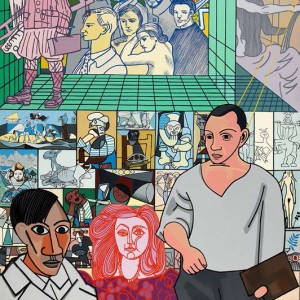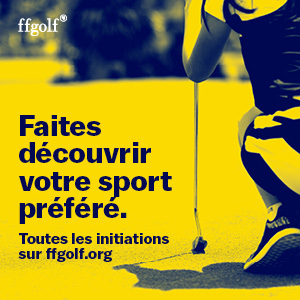Posted on September 15, 2015 in Arts & culture.
Picasso.mania exhibition at the Grand Palais

Erró, Picasso Antibes (detail), 1982, 195,5 x 132 cm, glycerophthalic painting on canvas, Musée Picasso Antibes
© Adagp, Paris / CNAP / photo Yves Chenot
The twenty or so exhibitions (monographic or collective) which, since 1973, have focused on the study of the posterity of Pablo Picasso's work bear witness to its impact on contemporary creation.
Both chronological and thematic, the tour of the Grand Palais exhibition retraces the moments of the critical and artistic reception of Picasso's work, the stages in the formation of the myth associated with his name.
From cubist still lifes to Musketeers of the Avignon exhibitions of 1970 and 1973, the exhibition's route is punctuated with works by Picasso, from the collections of the Musée national Picasso-Paris, the Musée National d'Art Moderne, as well as collections from the artist's family. Their presentation is inspired by the hangings made by the artist in his workshops, and the exhibitions he himself supervised (Galerie Georges Petit in Paris in 1932, Palais des Papes in Avignon in 1970 and 1973).
The major stylistic phases (cubism, late work ...), the emblematic works of Pablo Picasso (Les Demoiselles d'Avignon, Guernica) meet contemporary creations presented in monographic rooms (David Hockney, Jasper Johns, Roy Lichtenstein, Martin Kippenberger ...) or thematic, bringing together works combining the most varied techniques and media (videos, paintings, sculptures, graphic arts, films, photographs, installations, etc.).
The Polaroid montages, David Hockney's multi-screen video images echo Picasso's cubism, his exploration of a polyfocal space. At the start of the 60s, Pop artists on both sides of the Atlantic (Lichtenstein, Errό…) seized upon the portraits of the 30s through which the archetypal image of Picasso's painting was fixed.
The Shadow (1954) is at the origin of the series of four paintings undertaken by Jasper Johns in 1985 (The Four Seasons Reunited, are presented in the exhibition). Witnessing the impact of Picasso's public image on the imagination of twentieth century artists, on two occasions, in 1988 and 1995, Martin Kippenberger interprets the photographic portraits of Picasso and Jacqueline made by David Douglas Duncan. The variations, inspired by Les Demoiselles d'Avignon and Guernica, demonstrate the place occupied by these paintings in the history of modern art and, beyond, in the collective imagination (these two works are not presented in exposure given their impossible movement). Birth certificate of pictorial modernism, Les Demoiselles d'Avignon have been the subject of variations (by Faith Ringgold, Robert Colescott ...), which comment on the ethnocentric, masculine dimension of this modernity of which the work has become the emblem . From a historical reading of Guernica by Emir Kusturica to the revelation of the symbolic role played by its transposition into a tapestry adorning the walls of the United Nations Security Council (Goshka Macuga, The Nature of the Beast, 2009), the use of painting by Picasso in the struggle of American artists opposed to the Vietnam War with street demonstrations which brandish its image, a room shows how Guernica has become a universal social and political icon.
Thanks to exhibitions which have re-inscribed it at the heart of contemporary creation (A New Spirit in Painting, Royal Academy of Arts, 1981) or which have shed light on its meaning (Das Spätwerk. Themen: 1964-1972, Basel, 1981; The Last Years, Guggenheim Museum, 1984), the works of Picasso's last years have once again become sources of inspiration. His stylistic eclecticism, his "cannibalism" of the old masters, the free craftsmanship of late paintings inspired the generation of artists revealed in the early 80s (Georg Baselitz, Jean-Michel Basquiat, George Condo, Julian Schnabel, Vincent Corpet, etc.) .
The video installation by Rineke Dijkstra, I see a Woman Crying (Weeping Woman, 2009-2010) illustrates the presence of Picasso's work in the current imagination, in its most varied expressions, from cinema to digital images, video to comics.
- Commissioner General: Didier Ottinger, General Heritage Curator, Deputy Director of the National Museum of Modern Art - Center Pompidou
- Commissioners: Diana Widmaier-Picasso, art historian; Emilie Bouvard, Curator of Heritage at the Musée national Picasso-Paris
- scenography: bGc studio agency, Giovana Comana and Iva Berthon Gajsak
Pratical information
- location : Grand Palais, National Galleries entrance square Jean Perrin
- opening : Monday, Thursday and Sunday from 10 a.m. to 20 p.m. Nocturne on Wednesday, Friday and Saturday from 10 a.m. to 22 p.m. Closed on Tuesdays. Early closing at 19 p.m. on October 7, 8, 9, 12, 14, 15 and 16. Early closing at 18 p.m. on December 3, 24 and 31. Closed on December 25.
- during the school holidays : every day including Tuesday from 9 a.m. to 22 p.m. Sundays November 1 and January 3 from 9 a.m. to 20 p.m. Early closing at 18 p.m. on December 24 and 31. Closed on December 25
- prices : € 14, € 10 TR (16-25 years old, job seekers, large families). Free for children under 16, beneficiaries of RSA and minimum old age.
for more information : www.grandpalais.fr
Drawing Now Art Fair: Tatiana Wolska winner 2024
The invention of language by Gertrude Stein and Pablo Picasso
The history of French women's golf at Golf du Sorbier








